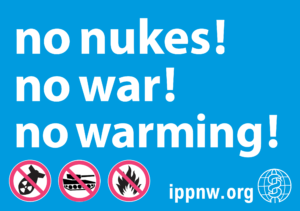IPPNW Delegation to COP28
From 30 November to 12 December, the 28th UN Climate Change Conference (COP28) will take place in the United Arab Emirates. For the first time, IPPNW is sending an official international delegation to COP to ensure human and environmental health is at the center of decision-making.
As physicians and health workers we warn that the climate crisis, militarisation and nuclear weapons pose an acute threat to global health. At the same time, enormous health benefits can be realised from overcoming our “fossil-fuel addiction” and destructive need for militarised power plays. At a hopeful point: for the first time, the topics of both health and peace will be part of the COP programme on 3 December 2023.
IPPNW’s calls to all COP parties:
1. Military greenhouse gas emissions accelerate climate breakdown, posing a severe threat to health and the climate. They should be included in negotiations and under the binding reporting of the UNFCC to meet the 1.5°C threshold.
2. The global arms race threatens health and the climate. Disarmament and demilitarisation can help finance climate mitigation. Cooperation and human security should be at the center of politics and decision-making.
3. Nuclear power is no solution to climate change, it has serious health consequences during its life cycle and increases the risk of nuclear proliferation. Cease the creation of new nuclear power plants, enact the rapid phase-out of nuclear energy generation, and shift to a just renewable energy transition.
4. Nuclear weapons pose an acute health threat to the planet and all its life forms. Climate agreements should urge that all governments join the UN Treaty on the Prohibition of Nuclear Weapons at the earliest possible date.
1. Militarisation and an on-going global arms race are exacerbating the climate catastrophe
Military activity is estimated to contribute 5.5 % of global greenhouse gas emissions as compared to 4.4% of the global health care sector, (albeit the purpose of one is killing and destruction whereas the other is set to sustain life). Yet their reporting remains voluntary under the UNFCCC and the official country data remains scarce. Studies increasingly show the impact of military carbon emissions, i.e. the Pentagon was responsible for more carbon emissions in 2017 than countries such as Sweden or Denmark. The climate and environmental effects of wars are even less accounted for. Researchers found that the first 12 months of war in Ukraine accounted for 119 million tons of CO2, as much as Belgium produced in the same period. While militaries and defence actors draft climate strategies, there is no evidence that a “greening” of the military is possible. Even if it were, the production and duration cycles of military equipment far outrun the closing window for climate action. The F-35 fighter jet for example produces 28 t CO2e on one tank of gas, equivalent to the annual average CO2 footprint of 4 German citizens or 70 Kenyan citizens. The F-35 is planned to be a cornerstone of NATO and U.S.-allied air power and to operate until 2070.
We need to cut emissions by half by 2030 to stay within the 1.5 degree limit and thereby ensure planetary and human health. We need to tackle military emissions.
2. Global military spending is higher than ever, diverting resources from climate action
In 2022 world military expenditure rose to $2240 billion, $82.9 billion were spent on nuclear weapons alone. Tackling the climate catastrophe will require finance for mitigation, adaptation and loss & damage, one of the main issues for negotiation at COP28. The Green Climate Fund and other financial instruments for climate action are notoriously underfunded. The last IPCC report stated clearly that fiscal space may need to stem from other sources and that “moderate reductions in military spending (which may involve conflict resolution and cross-country agreements on arms limitations) could free up considerable resources for the SDG agenda”. A report by several NGOs including IPPNW Germany found that the $1.26 trillion of NATO’s military spending in 2023 would cover the most polluting nations’ unfulfilled promise of climate finance of $100 billion a year for 12 years, or African countries’ climate adaptation and mitigation for 4 years. Instead militaries and the arms industry are using climate change as an argument to increase military budgets and capacities. Arms are being exported to countries that are climate-vulnerable and that are experiencing violent conflict, thereby exacerbating the double impact of violence and climate crisis.
3. Nuclear power is a dead end in the search for clean energy
In the face of the climate crisis, some are propagating a supposedly simple carbon-free way out: nuclear energy. But in fact, nuclear energy is too insignificant in a global comparison, too slow and too expensive for the rapidly needed decarbonisation and too dangerous for people and nature to be more than a distraction without any real and timely effect on climate action. On the contrary, the sheer incompatibility of large, inflexible base-load power plants with renewable energy sources makes nuclear power more of a brake than a solution. Nuclear energy’s dominant drivers still remain the nuclear weapon states. Of the 195 countries in the world, 33 currently operate nuclear power plants. More than half (57 per cent) of the electricity generated by these nuclear power plants is accounted for by just three countries: the USA, the world’s largest producer of nuclear power, followed by China and France. With Russia in fourth place in this ranking and South Korea in fifth place, these five countries alone accounted for 71 per cent of the nuclear power generated worldwide in 2021.
Nuclear power is expensive and unreliable, is losing importance relative to overall electricity production, lags behind renewables in terms of cost-effectiveness and output and is hence outdated. And nuclear power remains dangerous: Its radiotoxic consequences and health risks along the entire fuel chain, from the uranium pit to the question of final storage, remain an unresolved burden for future generations.
4. Nuclear weapons threaten catastrophic climate change
Nuclear weapons pose an acute existential threat to human and environmental health. A so-called “limited” nuclear war would have global catastrophic climate consequences. A new study by IPPNW shows that a nuclear war between India and Pakistan, both nuclear weapon states and often in conflict, using less than 3% of the world’s nuclear arsenals could kill up to every 3rd person on earth. Leaving 97% of the world’s nuclear weapons untouched, this plausible scenario would alter the world’s climate in such a way as to reduce harvest times for the staple grains on which many populations depend, leading to a global famine in the decades to follow.
Even when nuclear weapons are not used, their maintenance and production diverts upwards of $82.9 billion dollars per year which could go to necessary investments in renewable energy, loss and damage financing, and other climate mitigation efforts. Furthermore, the production of nuclear weapons alone causes immense human and environmental harm.
The solution to the climate crisis must include nuclear disarmament.


